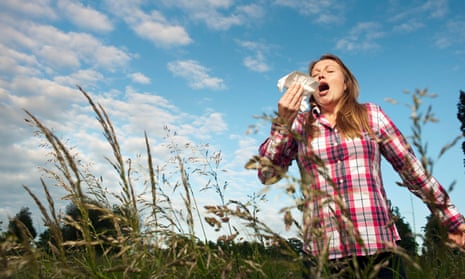The climate crisis is multiplying the miseries faced by people with allergies, with new research finding that the pollen season in North America is now an average 20 days longer than it was three decades ago.
Rising global temperatures are helping lengthen the period of time, typically in spring, when pollen is released by plants, trees and grasses, according to the study, published in Proceedings of the National Academy of Sciences.
In an analysis of 60 pollen-collecting stations across the US and Canada, the pollen season is now 20 days longer on average than it was in 1990. The season is also becoming more intense, with significantly larger quantities of pollen being detected.
This increase is strongly coupled with global heating, with the researchers using climate modeling to show that climate change is responsible for at least half of the additional days of pollen activity. There is also some evidence the growing concentration of carbon dioxide in the atmosphere may in itself be helping spur the increase.
“We are getting warmer winters, warmer springs and earlier springs and that is driving a lot of this,” said William Anderegg, co-author of the study and a scientist at the University of Utah, who became personally interested in the topic because of his own seasonal hay fever. “This is a really clear example that climate change is already here, in essence it’s here in every breath we take. The health impacts are with us and likely to get worse.”
Tiny pollen grains, expelled to propagate plants, can trigger seasonal allergies in some people, causing sneezing, itchy red eyes and runny noses. Pollen season can also worsen other conditions, such as asthma, and such ailments have been linked to poor school performance and knock-on economic impacts.
Anderegg said the pollen season was probably lengthening in other parts of the world, too, although some regions would be limited by water availability. “We don’t really know how far it will go from here, we don’t have a lot of pollen monitoring compared to other types of air pollution,” he said, adding that a public health response could include warnings on high pollen days and air filters for buildings.
The study is the first to be able to attribute the growing pollen season to climate change, according to Kristie Ebi, an epidemiologist at the University of Washington who was not involved in the research. “As the climate continues to change, without additional adaptation to prepare for and manage the impacts … the numbers of cases of asthma and allergies due to aeroallergens would be expected to increase,” she said.
Aaron Bernstein, an academic at Harvard’s school of public health and a doctor at Boston children’s hospital, said he was seeing more and more children suffering from allergies and asthma.
“The future is now,” he said. “We are seeing the health harms of climate change more clearly each year. The worsening allergy season is one of many reasons for major climate action now, not merely to prevent immense harms, but to promote a healthier, more just, and sustainable world.”
